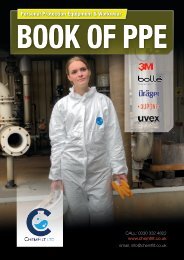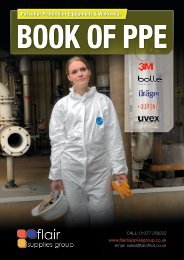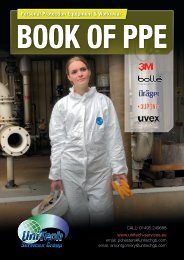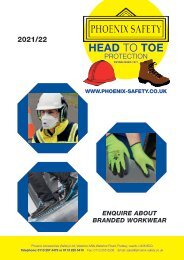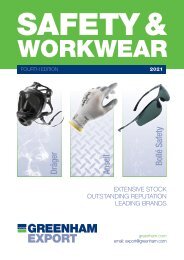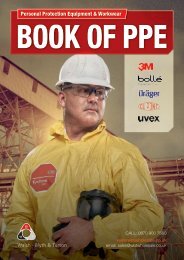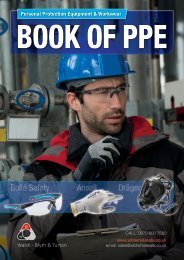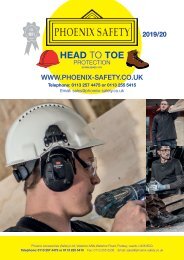Phoenix Safety Head to Toe Protection Catalogue 2021
Phoenix Safety Head to Toe Protection Catalogue 2021
Phoenix Safety Head to Toe Protection Catalogue 2021
You also want an ePaper? Increase the reach of your titles
YUMPU automatically turns print PDFs into web optimized ePapers that Google loves.
Hearing <strong>Protection</strong><br />
Buying Guide<br />
LEGISLATION UPDATE: From 21st April 2018 hearing protection will be re-classified<br />
from Category II <strong>to</strong> Category III types of risk. New products placed on the market from<br />
this date will face even stricter tests for conformity and certification.<br />
Existing hearing protection can continue <strong>to</strong> be placed on the market under a Cat II EC<br />
Cert until 21st April 2019. After this date ALL hearing protection needs <strong>to</strong> be certified <strong>to</strong><br />
Cat III under the regulation.<br />
Product already on the market (with distribution) can continue <strong>to</strong> be sold under either.<br />
As a responsible PPE supplier you can have confidence that our products will meet<br />
conformance <strong>to</strong> the existing and new standards as appropriate.<br />
Step 1. Detection<br />
When a noise survey is required, it must be carried out by<br />
a competent person such as a noise consultant.<br />
Step 2. <strong>Protection</strong><br />
Use the information gained during the survey <strong>to</strong> select HPE<br />
with the right level of attenuation.<br />
Step 3. Education and training<br />
Not every member of your workforce will know all the<br />
benefits or understand how best <strong>to</strong> use their protection.<br />
Step 4. Validation<br />
Every user is different, how do you make the workforce<br />
is adequately, individually protected?<br />
Just because it fits, doesn’t mean it works<br />
There are many helmet manufacturers who produce ear muffs for use<br />
with their helmets. There are also many manufacturers that specialise<br />
in producing one or the other, and distribu<strong>to</strong>rs will offer a range of<br />
both products <strong>to</strong> give you the best choice. If you select products from<br />
different sources, make sure you check that the ear muffs have been<br />
tested on the specific make and model of helmet with which you plan<br />
<strong>to</strong> use them. Manufacturers are well aware of the situation and many<br />
co-operate <strong>to</strong> have their products tested <strong>to</strong>gether, so that the cus<strong>to</strong>mer<br />
can select the combination they prefer as the most appropriate.<br />
So, if you want <strong>to</strong> use an ear muff with a particular helmet, make<br />
sure they have been certified <strong>to</strong>gether.<br />
Remember, just because it fits, doesn’t mean it works.<br />
SNR<br />
39<br />
SNR (Single Number Rating).<br />
SNR is the number of potential decibels the hearing protection will<br />
reduce the noise level by, if fitted correctly.<br />
The aim is <strong>to</strong> find a suitable product that brings noise level down <strong>to</strong> between 70 and<br />
80 decibels. Over protection should also be avoided, as people may not be able <strong>to</strong> hear<br />
important every day sounds. SNR is only a general means of comparing different sound<br />
protection levels for different hearing protection.<br />
156<br />
Bristish <strong>Safety</strong> Industry Federation<br />
Most safety helmets have a facility, usually an accessory slot at each side,<br />
<strong>to</strong> allow them <strong>to</strong> be fitted with earmuffs and other accessories. Also, many<br />
manufacturers offer helmet mounted earmuffs specifically for the purpose.<br />
Often the fitting points of the helmet and earmuff are of a ‘standard’ size<br />
and style, but here a significant issue arises:<br />
If you select a helmet and earmuffs from the same manufacturer, it is likely that<br />
they have been approved for use <strong>to</strong>gether. The manufacturer in question should<br />
make this clear in the product information. If, however, you select a helmet from one<br />
manufacturer, and helmet mounted earmuffs from another, they may well fit <strong>to</strong>gether,<br />
but unless you can see that they have been performance tested <strong>to</strong>gether there is<br />
nothing <strong>to</strong> show the earmuffs will provide protection!<br />
One of the features determining the performance of earmuffs is the force produced by<br />
the spring arm. This is <strong>to</strong> maintain the seal of the cushion around your ear.<br />
You may have selected the most suitable helmet for you or your workforce, and also<br />
the most appropriate earmuff for the noise hazard, also taking in<strong>to</strong> account weight,<br />
comfort, user acceptance, etc, but without testing for use in combination you cannot<br />
assume that the earmuff will provide the expected protection.<br />
Both the helmet and the earmuffs should be CE marked. This mark shows that a<br />
product meets the necessary legal requirements however it does not tell you anything<br />
about its performance for any given application or task.<br />
There are different ways <strong>to</strong> gain the CE mark but the most common is <strong>to</strong> have a<br />
product certified using a harmonised European standard (see ‘CE Marking and Product<br />
Certification’ below). For helmet mounted earmuffs the standard is EN352‐3, and it<br />
requires products <strong>to</strong> be tested <strong>to</strong>gether and manufacturers <strong>to</strong> specify the models of<br />
helmet tested with the earmuffs.<br />
RNR*



